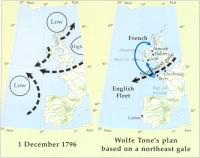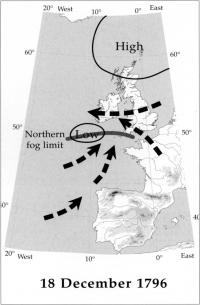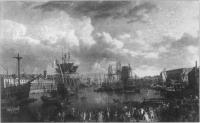Weather & Warfare Bantry 1796 revisited
Published in 18th–19th - Century History, Features, Issue 4 (Winter 1996), Volume 4
Theobald Wolfe Tone
No one in 1796 would have believed that it could happen. For a French fleet to sail from Brittany into Bantry Bay through the massed blockading fleet of the British navy and back again, without making any significant contact or engagement, would require a miracle of immense proportions. This achievement puts the significance of the weather in the events of December 1796 into context. It was both an ally and an enemy. The expedition began in disarray and ended in disaster, in no small part due to the changing weather conditions of that fateful month. But there were also moments of opportunity which were lost. The recent reconstruction of weather maps for the period of the expedition has provided a detailed picture of the weather’s role in its eventual outcome.
The 1790s come towards the end of what has become known as ‘The Little Ice Age’. The winters were generally colder and easterly winds were much more frequent than they are today. Indeed, the month of December shows the greatest contrasts between then and now. For example, during the Decembers of 1780-1785 the easterlies were dominant over westerly winds, although this may not have been as strong a feature over the longer period, for westerlies were still very important. Nevertheless, Wolfe Tone’s weather memory and the expectations which that produced meant that his expectations of easterly winds occurring during December would have been high. Indeed, his planning strategies reflected this.
From the data contained in ships’ logbooks, Tone’s diary and from weather observations made at Armagh Observatory, Dublin, Manchester, Edinburgh and Rutland, weather maps have been reconstructed for each day between 1 December 1796 and 5 January 1797. The period can be divided into four stages: 1-16 December, the period of preparation, planning and eventual departure of the French fleet from Brest; 17-20 December, when the fleet was dispersed and progressed very slowly into Irish coastal waters; 21-27 December, when the fleet attempted to land at Bantry Bay; and 27 December-2 January 1797, when a new rendezvous also failed.
Preparations: 1-16 December
For the first half of December, while the invasion fleet was being assembled at Brest, the weather was almost like summer. In the shelter of the west-facing harbour, the easterly winds from a high pressure area to the east and north-east of Britain lost much of their bitterness and under the clear sunny skies Tone felt positively warm. These conditions extended over Brittany, the Channel and the seas around Ireland. Out of the sun, however, the air was very cold. Mid-day outdoor temperatures recorded at Armagh varied between 31 and 39 °F (approximately -5 to 3.9 °C). Unbeknownst to those on land, the easterly winds were converging into an area of low pressure west of the Bay of Biscay, producing gale conditions, where the blockading British fleet struggled to cope with them (fig.1). This was in stark contrast to what was being experienced on land. Those waiting in Brest had no way of knowing what was happening so far out to sea.
If the French had been assured of naval superiority over the British these pressure and wind conditions would have been very favourable for launching the expedition and reaching Ireland. However, this was not the case. Since the Revolution the French navy had been neglected (many of its best officers has fled into exile) and was widely regarded as second-rate. A successful landing in Ireland required avoiding the British fleet patrolling the seas between Brittany and Ireland.
To counter this blockade Tone proposed a strategy dependent on the weather conditions. It required a northeast gale to displace the British fleet westwards and allow the three or four fastest French ships to leave, with troops, under cover of darkness and sail to the north of Ireland, where the United Irishmen were strongest and a rising imminent. He then expected the British fleet to withdraw and redeploy to deal with the threat in the north. This would open up the way for the main embarkation which would land in the south and catch British land forces between two fires. Tone thought this would be decisive (fig.2).
For a variety of reasons this strategy was turned down. The only alternative which Tone thought might stand some chance of success, also depended upon suitable weather conditions. This was an extremely strong westerly storm of two or three days duration which would displace the British fleet eastwards up the Channel, and would enable the entire French fleet to set off before the British could return to their blockading positions. Westerly winds that were anything less than storm force would trap them in Brest harbour, make the troops on board ill and exhaust their food supplies waiting for yet another change in the weather. All options, therefore, depended upon the weather. But as it was, the wind and weather remained largely unchanged.
 The crossing: 16-20 December
The crossing: 16-20 December
The waiting ended on 16 December. The weather had little to do with the timing of the departure. The wind remained easterly, which was favourable for the journey to Ireland. The fleet had just been reinforced and for the first time everything was ready. On the 15th, in clear warm weather, the vessels moved to the outer harbour, ready to depart as one. It was the last time they were to be together. In an attempt to avoid the British fleet off Ushant, Vice-Admiral Morard de Galles gave the order to leave the harbour by a southerly passage through the narrow and dangerous Raz de Seine, instead of through the main Iroise Channel. To further conceal the manoeuvre it was carried out at night. The manoeuvre was not a success. The Raz was too dangerous to negotiate in the dark and de Galles changed his mind halfway through the operation. Amid great confusion the French fleet split up, the admiral and commander-in-chief set off with a few vessels following and the Seduisant was wrecked.
 The Indomptable, with Tone on board, was one of twelve vessels which successfully passed the Raz (although with great difficulty). Among these was the Immortalité with Rear-Admiral Bouvet and General Grouchy on board, who effectively became the expedition’s leaders. 17 December was a good day for most of the fleet; in the benign weather a considerable number of the scattered ships located the Indomptable and the Immortalité as they took a course to the west-north-west with a favourable wind behind them.
The Indomptable, with Tone on board, was one of twelve vessels which successfully passed the Raz (although with great difficulty). Among these was the Immortalité with Rear-Admiral Bouvet and General Grouchy on board, who effectively became the expedition’s leaders. 17 December was a good day for most of the fleet; in the benign weather a considerable number of the scattered ships located the Indomptable and the Immortalité as they took a course to the west-north-west with a favourable wind behind them.
At this point the weather began to change. The meteorological records at Armagh show that atmospheric pressure had been declining very slowly for the previous few days. Reconstructed wind fields indicate that a weak frontal depression had been advancing slowly from the southwest and was about to replace the easterlies that had dominated the weather for so long. While the progress of this new weather system was slow, the changes it brought were dramatic. The advancing warm front introduced moist tropical air which gradually cooled during its progress north-eastwards between latitudes forty and fifty degrees. The relatively cold sea with seasonally low temperatures was enhanced by the long period of cold easterly air that had prevailed to date. This resulted in an extensive thick fog and mist which enveloped both the French and the British fleets during the night of the 17th and throughout the 18th (fig.3). At times it was so thick that it was not possible to see a ship’s length. While this gave a cloak of invisibility to the French, it also prevented those still scattered from rejoining the main fleet. In addition, the wind was very slack so progress was slow.
The fog persisted over the Atlantic approaches to Ireland south of latitude 50° N where most of the British fleet was deployed and westwards out into the Atlantic. Indeed, Colonel Shee, with the French commanders on the Fraternité, which had become detached from the main fleet and was now much further to the west, was later to inform Tone that the fog had enabled them to sail for twenty-four hours unnoticed in the middle of the British fleet. But to the north along the Irish coast the weather favoured the expedition. Here, apart from two patrolling British ships and HMS Magnamine (in Cork harbour), the coast was clear.
So the French passed through the fog but did not realise their advantage. On 19 December the easterly wind continued to favour them and brought them into position off the coast. It also aided a number of stragglers in re-joining the main fleet. Even in such favourable weather the French still found it difficult to keep together, much to the frustration of Tone. Since the Fraternité, with both commander-in-chief and admiral on board, was still missing, instructions prepared for such an eventuality required the fleet to wait for five days off Mizen Head until contact was restored. By the 20th most of the stragglers had rejoined, but there was still no Fraternité.
The low pressure controlling the weather, and in particular the location of the fog, remained fairly stagnant for two days moving slowly eastwards across southern England to the North Sea. Travelling in the wake of the depression was a following cold front which caused the winds to veer to the northwest. So on the 20th as the French completed their journey towards Mizen Head they found the wind picking up and becoming a head wind. These conditions favoured entering Bantry Bay but the Fraternité was still missing.
Events in Bantry Bay: 21-27 December
The cold front passed over the southern parts of Ireland and England quite quickly. Cold fronts typically introduce polar air with vastly improved visibility. Indeed, the fleet had been spotted early on the morning of the 21st by Mr White of Seafield House, Bantry, whose information was passed to Admiral Kingsmill in Cork. The cold front had also deposited snow over Ireland. Snow fell on the Cork mountains and
Armagh had reported snow on the night of the 20th/21st. Therefore, it is likely that the snow was widespread. Whether this would have been sufficient to slow any rapid response by a defending army, is uncertain. But still the fleet waited, sometimes going with the wind and sometimes against it.
The wind speed had been quite moderate and had posed no major problems for the French. But another advancing low pressure system from the southwest sharpened the pressure gradient and strengthened the wind on the 21st. On the 22nd the area of high pressure was expanding westwards again blocking the normal northward track for winter depressions, diverting it eastwards. This brought northerly winds over Armagh and a return to easterly winds over the south coast. These became very strong and reached gale force by 22 December. Bouvet and Grouchy, now the leaders of the expedition, decided to wait no longer and to proceed up Bantry Bay to land their force. However, once the gale had become severe this proved an impossible task, so that Tone recorded, ‘We have been tacking ever since eight this morning, and I am sure we have not gained one hundred yards; the wind is right ahead and the fleet dispersed’.
Through the night of 22nd/23rd strong gales continued to batter the French and more snow fell, not only on the mountains, but on lower ground as well. The gales dispersed the French fleet even more and made impossible the usual tactic of placing a frigate at the entrance to the bay to warn of any approaching British vessels.
But the intensity of what proved to be a series of storms was yet to peak. On the morning of the 24th it was still possible to row between the Immortalité and the Indomptable to hold a council of war. Progress up the Bay was another matter. In frustration Tone recorded that ‘though we have been under way three or four hours, and made I believe three hundred tacks, we do not seem to my eyes to have gained one hundred yards in a straight line’.
On land, the weather was also having an effect on events. Lieutenant Pulling had been sent by Admiral Kingsmill to find out what was happening. He arrived in Bantry at 3pm on the 24th, where he observed what he could until darkness fell. The dense haze produced by the weather made a positive identification of the vessels in the bay very difficult. The French underestimated the uncertainties this caused on land. Pulling could see no flags or pennants and could only conclude of the three most visible ships that ‘I am certain [they] were not English built’. The weather was too severe to get closer by boat. He did not exclude the possibility that the fleet was an enemy, but he was confident that the weather would not allow them to sail further up the bay.
Late on the 24th the wind eased, as the depression that had produced the storms moved away. Tone hoped to land the following day. There was no immediate attempt to take advantage of the improved conditions, because of darkness. The respite was extremely brief. A new deep low approached rapidly from the southwest. Strong gale force winds around its north and northeast flanks generated easterly and southeasterly gales respectively as the centre of the depression travelled eastwards towards Ireland, bursting on the scene in the early morning hours of the 25th, so that Tone recorded ‘it is absolutely impossible to work up to the landing place’.
The gales persisted all day and made communication, by rowing boat, impossible. As night fell the struggling Indomptable put out two anchors to hold it in position in the face of the heavy easterly gale. Easterly and south-easterly gales were to last from 25 to 27 December. They were widespread west of a line from Cherbourg to the Shannon. The depression responsible for them, although vigorous, moved only slowly. As with its predecessor, it tracked again eastwards to the south of Ireland rather than northwards. This new storm was too much for Admiral Bouvet in the Immortalité who, convinced that the fleet was in danger of being lost, decided to leave the bay. Part of the fleet had already been blown out to sea, while other vessals could barely hold their position, their anchors dragging.
The morning of the 26th brought no improvement in the weather. For those in the bay the new day brought an additional problem: despite the gale continuing unabated, fog now shrouded the area so that any manoeuvres by one vessel might prove a hazard to others. It was so thick that Tone recorded that it was impossible to see a ship’s length. To follow the Immortalité out into the open sea by running before the wind in such poor visibility when most of the fleet were downwind of them would have been hazardous in the extreme. So, there was no alternative but to stay where they were. Even when the fog cleared later in the morning the Indomptable remaind in the bay to ride out the storm with a handful of other ships. The departure of the Immortalité and the loss of any element of surprise over their enemy now made a landing at Bantry appear impracticable. Tone held the weather ultimately responsible, for ‘notwithstanding all our blunders, it is the dreadful stormy weather and the easterly winds, which have been blowing furiously and without intermission since we made Bantry Bay, that have ruined us’.
On the morning of the 27th it was considered safe enough to sail the remainder of the force out of Bantry Bay. Conditions had eased sufficiently for the leading officers to assemble for a council of war. An alternative strategy was now unanimously agreed upon. They were to proceed to the Shannon where it was hoped that more of the fleet would assemble and be able to make a successful landing. At last the wind direction changed significantly. As the depression moved away and high pressure built up strongly to the north east, so the wind swung round to a southerly direction, favouring the new strategy. The remaining fleet of ten ships, including seven frigates, left the bay and faced the open sea.

Brest in 1794(Musee de la Marine, Paris)
The retreat: 27 December-2 January
The remnants of the French fleet that left Bantry Bay were battered but unbowed. The invasion was not over. But as the hopes of making an alternative landing rose, so the weather was to take a final hand in the affairs of the expedition. Late on 27 December Tone recognised the signs of a stormy night ahead. The storm was more than had been expected, ‘a perfect hurricane’, with exceptionally rough seas, which almost sank the Indomptable. The storm caused widespread damage in the southwest. But the wind abated suddenly and the morning of 28 December saw them reach their new rendezvous off the Shannon estuary. Here they spent an uneventful day waiting for other vessels.
The depression that had produced this fearsome storm moved quickly northwards. Although the winds had abated, they were still strong and continued to be hazardous and the Impatient was wrecked off Crookhaven. The few survivors that made it to shore thought the fleet had dispersed and reported discontent among the crew and a shortage of rations right from the start of the expedition.
But on 29 December the expedition came to an end as far as Tone was concerned. At four in the morning the decision was made to leave for France. The delays induced by the severity of the weather meant that supplies were so low that there was hardly sufficient to get everyone back to France. After they left there were to be a few other late arrivals at the rendezvous. Two of the original fleet arrived on 1 January but rightly concluding that any others who had weathered the storm had abandoned further attempts at a landing, they departed on 2 January. The retreat did not prevent opportunistic diversions on the return journey to France. Off the coast of Ireland the Indomptable sank a merchant vessel travelling between Lisbon and Cork. But that was the first and last of the action Tone was to experience in the whole expedition.
Although Tone had headed back to France there were new arrivals in Bantry Bay. Late on 30 December five of the original fleet arrived off Whiddy Island, hoping to join up with the rest of the fleet. The following day others joined them and precautions against a landing were taken in Bantry. But they sailed at 3pm on 2 January, after scuttling the Surveillanté. The remaining nine vessels took advantage of another southeast gale to leave the bay, although they did not completely clear it until 4 January. The Fraternité, with Hoche aboard, never arrived. Still heading for Bantry Bay it met the badly damaged Revolution taking men off the sinking Scevola and learned the fate of the expedition.
As for the British fleet, they were mostly in port or sheltering along the Irish and English coasts. The nearest naval force was in Cork harbour. Although some of the ships there had come through the storms with little damage, the continuing southeast gales with very poor visibility delayed the pursuit of the French by the British squadron, which was not able to leave Cork until 4 January. By that time the French were well on their way back home.
Conclusion
The evidence of the daily synoptic conditions shows that a wide range of weather conditions was experienced during December 1796, from almost summer-like calm, dry, sunny weather to the most severe storms and intensely cold, snowy weather. Despite the inferiority of the French fleet the weather was by no means entirely against its success. However, the French failed to take the opportunities that presented themselves and were then confronted by a series of storms which prevented a landing, prevented communication between vessels at critical times, and exposed the men to weather extremes which they suffered under increasing privation as food supplies seriously diminished. So the weather drove them from Bantry Bay, and then dealt them one final blow on the night of 27 December. The dispersal of their force made the abandonment of the expedition the only reasonable course of action. The synoptic reconstructions show that while easterly gales were severe, the most significant storms came from low pressure systems approaching Ireland from the southwest.
Because of the weather, there was relatively little warfare in this expedition. If the weather conspired to do anything, it was to keep the protagonists apart. It denied a landing to the French, but it also denied the British a convincing victory. The legacy of no solution was to leave the way open for further attempts on Ireland, which came to fruition in 1798.
John Tyrrell lectures in geography at University College Cork.
Further reading:
R.B. O’Brien (ed.), The Autobiography of Theobald Wolfe Tone 1763-1798 (London 1893).
J.G. Tyrrell, ‘The Weather and Political Destiny’ in J.A.Murphy (ed.), Proceedings of the Bantry Bay Summer School, 1996 (Cork 1996).
















